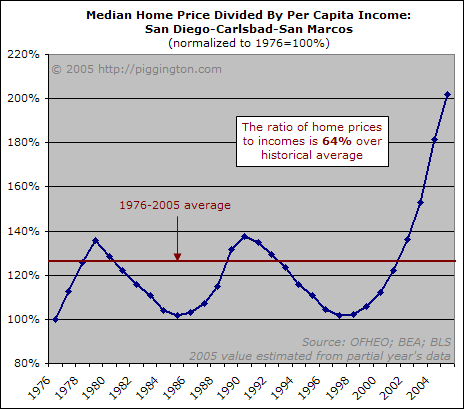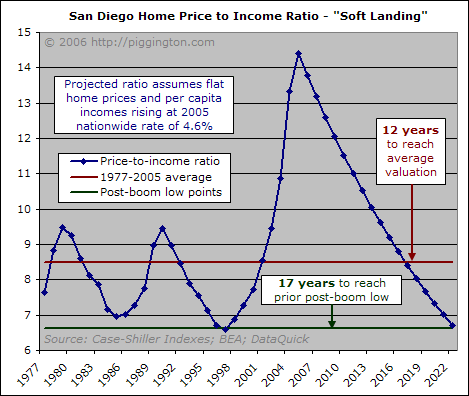To no one’s great surprise, Ben Bernanke has been chosen as the next chairman of the Federal Reserve. What, if anything, does this mean for housing?
To begin with, let’s take a look at where the housing market stands from a historical perspective. It’s easy to see that the ratio of San Diego home prices to incomes is likely to drop substantially:

The question is: how much of this adjustment will come from nominal home prices dropping, and how much will come from nominal incomes rising (otherwise known as inflation)? That’s what we really need to figure out.
At the current rate of wage inflation, and assuming flat home prices, it would take almost two decades for San Diego’s home price to income ratio to normalize:

Despite the ubiquity of predictions for price flattening, it’s simply not going to play out that way. Prices need to come back to earth a lot sooner than 2025. Therefore, a steep fall in San Diego home prices is practically inevitable unless inflation starts to increase significantly.
Enter Ben Bernanke, our next Federal Reserve chairman. In short, the likelihood of increased inflation just got a big boost. This is because Dr. Bernanke, while admittedly looking like a fuzzy, lovable teddy bear…

…is quite cavalier about firing up the old dollar printing press.
I refer to a famous speech Bernanke delivered in 2002, in which he made it clear that he would do whatever it took to prevent “deflation” (by which he meant a fall in the Consumer Price Index) from taking hold in the US. He pointed out that dollars “have value only to the extent that they are strictly limited in supply,” and argued that the government should drastically increase the supply of dollars if CPI growth starts to head towards negative territory. He then discussed several options for increasing money supply, from dropping the Fed target rate to 0%, to printing money in order to buy up longer terms bonds, to printing money to monetize huge tax cuts (a move which he likened to dropping money from helicopters).
The point here is that Bernanke has made his priorities clear. Whether he actually calls in the chopper fleet or not, he advocates finding a way to decrease the value of the dollar as much as he has to in order to keep the CPI from going negative.
As an editorial aside, I believe this is a very short-sighted approach. Artificially stimulating the economy in the short term always presents negative long-term repercussions. Bernanke should just ask Greenspan, whose post-stock bubble attempts to keep us out of recession via a negative real Fed rate resulted in a housing bubble and a massive accrual of foreign debt. This type of meddling always does more harm than good in the long run.
But, back on topic, it’s probably good for home prices. Let’s turn back to the chart from the beginning of this article. As the dollar declines in value, wages will likely rise to keep pace. To the extent that incomes rise, the home price to income ratio will decline, obviating the need for such a huge decline in nominal home prices to take place.
Of course, this is sort of a best-case scenario. If Bernanke gets too enthusiastic about debasing the dollar, for instance, foreign central banks might get spooked and start selling off their rapidly-depreciating dollar holdings. This would cause a spike in interest rates and a sharp rise in import prices, both of which would be very bad for housing. Alternatively, wages might not end up rising alongside the increased supply of dollars. There are several potential outcomes, many of them not so good.
The game Bernanke proposes playing is a dangerous one. It remains to be seen how well he plays it, and for that matter whether he ends up playing it at all. For right now, though, I believe Bernanke will probably soften (if only mildly) real estate’s inevitable hard landing.
Personally, I was hoping that Fed vice-chairman Roger Ferguson would get the top spot. Not because of anything he’s said or done, but because of his calamitously nerdy Coke-bottle glasses:

That, my friends, is what an economist ought to look like.
